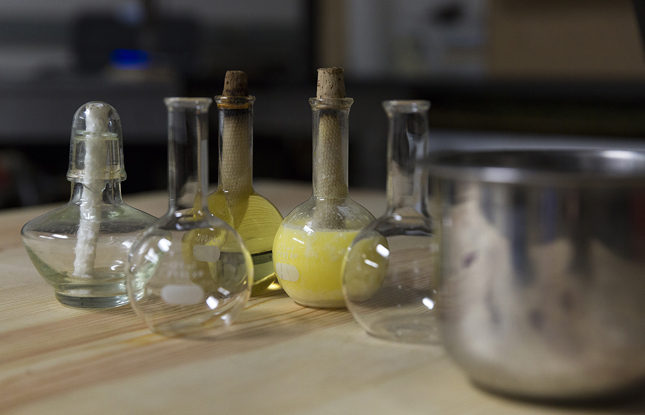
On September 24, red-hot demonstrations of scientific glassblowing at UW-Madison drew a standing-room-only crowd to the meeting of the American Scientific Glassblowers Society (ASGS) Midwest Section. Open to the public, the meeting, hosted by the UW-Madison Glass Lab, showcased the bending and blowing of glass tubing to create scientific apparatus, an art that began in 19th-century Germany and continues in research-active chemistry departments to this day.
L&S master scientific glassblower Tracy Drier (Chemistry) helped organize the event. Drier, the builder of the widely used Wisconsin Schlenk Line (a graceful glass valve system called “a thing of beauty” in scientific circles), received the 2016 Chancellor’s Award for Excellence in Research in April.
Assistant Professor of Art Helen Lee hosted the event, and Assistant Professor of History of Science Catherine Jackson gave the keynote talk. Here is Jackson's perspective on a fiery intersection of art, history and science:
“I gave my talk on the Kaliapparat, a small, triangular piece of glass apparatus that Liebig made in the fall of 1830 to measure how much carbon was contained in morphine — at that time the world’s best painkiller and one of only a handful of pure chemical remedies in medical use. Understanding the chemistry of morphine was an important goal of scientific research.

As a historian, I’m interested in how science is done and why it works.
But the Kaliapparat also showed Liebig the limitations of the analytical approach to organic chemistry. Two students in Liebig’s laboratory became the first chemists in the world to do organic synthesis, launching what by 1900 became one of the most powerful and productive sciences the world had ever seen. Synthetic organic chemistry is essential to the production of new drugs and innovative materials. Liebig’s Kaliapparat also drove what I call the 'glassware revolution.' This was when chemists began to work almost exclusively in glass apparatus, and this was why the scientific glassblower was born.
Many of the earliest scientific glassblowers also trained in decorative glass working, and glassblowing skill continues to transcend any division between the arts and the sciences.
As a historian, I’m interested in how science is done and why it works. You can’t answer those questions without understanding technique and expertise — and those are things that are shared by the arts and the sciences, whatever historical period or area of science you focus on.
Many of the scientific glassblowers at the meeting told me how much it mattered to them to hear about the history of their profession and its relationship to the historical development of science.







